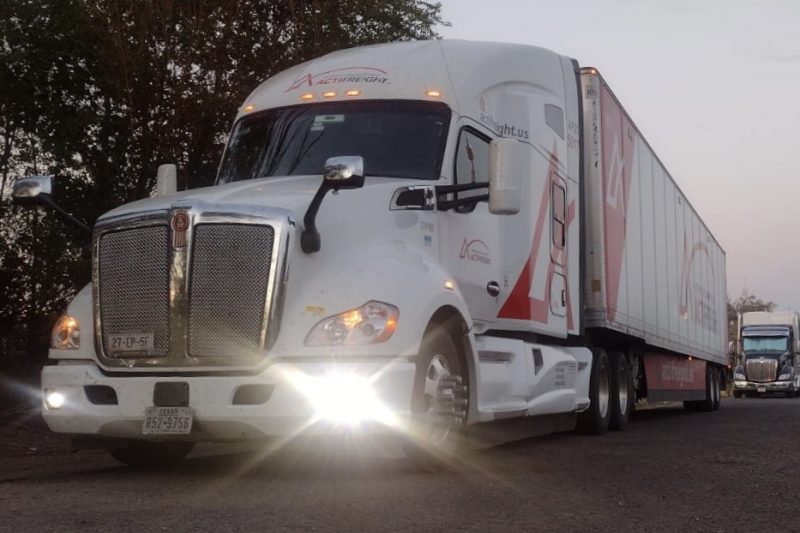‘I Can’t Let You Down’: How Mexican Truckers Are Easing U.S. Driver Shortage While Helping Their Families Back Home
By Ana Paola Davila Chalita
Reporting Texas

Juan Martinez’s truck as it makes it way through Jonestown, Pennsylvania, in November.
Juan Martinez starts driving by 7 every morning after he takes a yogurt and some fruit from the small refrigerator next to the bunk bed inside the truck he calls home.
He drives for 11 hours, sleeps for 10 and spends the other three in truck inspections and rests along the road.
A trip usually lasts from Monday to Saturday, starting in Mexico and going north into the United States before returning home. Once he is back in Nuevo Laredo, he gets to rest in a hotel for 34 hours before going out on the road again.

Juan Martinez takes a selfie with his truck in Klamath Falls, Oregon.
Martinez is one of thousands of truck drivers from Mexico, taking jobs to haul freight across the border under a 1991 commercial trucking agreement between the United States and Mexico. By 2021, 97,705 Mexicans had a license to move freight, according to a statement released by the Commercial Vehicle Safety Alliance, and 6.45 million commercial motor vehicles crossed the border in 2020 alone.
The opportunity of a higher salary is driving more Mexicans with a B1 visitor visa to a profession that is constantly struggling with a worker shortage.
“We need more. We need whatever approiate reforms or support from our federal government needs to be put in place so that we can invite more drivers into our state from other countries that want to be here and doing it right,” said John Esparza, the CEO and president of the Texas Trucking Association.
According to the American Trucking Association, last year the wage for American truckers rose by 18%, an increase meant to fill the gap for the 81,000 record high trucker shortage in 2021.
“There was a time where those truck driving positions, I would argue, were not paying well,” Esparza said. “I don’t think that’s the case anymore. You can make a really good living in the trucking industry driving a truck.”
But in 2022 the industry still needs 78,000 drivers, “The price of everything we buy is going to go up,” Esparza said, “because it’s going to cost more to move it, because we have less drivers that want to move it.”
“We’ve got a lot of work to do to ensure that we’re going to grow our base of drivers, or else the rest of the country is going to continue to feel the pinch,” he said. “These are jobs that Americans are not taking.”
Being a trucker isn’t for everyone, after all, it involves spending weeks on the road away from home. But for some Mexicans, it has become a way to make ends meet and achieve the American dream legally and without having to leave their home.
Martinez stays on the road for two months before going home to his family in Mexico City for 10 days. “While on the road, I miss them. It is not the same to only do video calls,” Martinez said, “but then it feels great when you are able to send them good amounts of money.”
Companies can hire non-American drivers to move international loads if they have a B1 visitor visa and follow all customs regulations. “That makes them eligible to move freight out of their countries and into the United States,” said Esparza.
The way it works: Truckers load in Mexico and take the cargo to the final destination inside the United States. They then load new cargo to take back across the border into Mexico. Freight must go directly from one country to another. The B1 drivers cannot haul freight from one U.S. destination to another.
Martinez, who has been a B1 truck driver for 10 years, works at Actifreight, a freight company based near Laredo. B1 drivers are paid in Mexican pesos, making 45 cents per mile. He is making $22,000 pesos per week, the equivalent to $1,136.
A B1 driver’s income is more than double what could be earned in Mexico, where they are usually paid 20 cents per mile. “No professional in Mexico is earning what we are earning,” Martinez said.
That salary allows Martinez to have an above-average quality life in Mexico City. His 27-year-old daughter graduated from one of the best Mexican universities; his son goes to private school, wants to study medicine and is looking to apply to Baylor University. He has his own house and supports his wife’s business financially.
Actifreight employs 33 B1 Mexican drivers. “In the U.S. there are not enough people willing to take the job,” said Juan Ramos, Martinez’s boss, who is Actifreight’s terminal manager.
According to Esparza, a possible explanation for this is a generational loss of interest in the job, and a wide variety of competition in the workforce.
The increased number of online deliveries, and an aging workforce contribute to the trucker shortage.
The industry will need a million more truckers to satisfy the demand in the next decade, the American Trucking Association estimated.
“Having a shortage of operators, you cannot move merchandise unless you pay a lot and it moves before the others, and ends up causing inflation,” Ramos said.
That is why B1 drivers are a solution to the problem. “They move the trucks that otherwise would be parked,” he explained.
For him, truckers “keep America rolling, fed and warm.”
Like Martinez, B1 drivers spend a big part of their salary in Mexico, helping both countries economically.
“I am working legally,” Martinez said. “If you are giving me the trust to work in your country, I can’t let you down.”